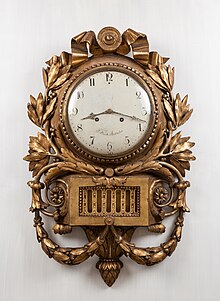
Back Сыхьат ADY Klokhorlosie Afrikaans Uhr ALS ሰአት (መሳሪያ) Amharic Reloch AN Òfuk-mgbọ ANN ساعة (آلة) Arabic ساعة (دوزان) ARY ساعه (اله) ARZ ঘড়ী Assamese

A clock or chronometer is a device that measures and displays time. The clock is one of the oldest human inventions, meeting the need to measure intervals of time shorter than the natural units such as the day, the lunar month, and the year. Devices operating on several physical processes have been used over the millennia.
Some predecessors to the modern clock may be considered "clocks" that are based on movement in nature: A sundial shows the time by displaying the position of a shadow on a flat surface. There is a range of duration timers, a well-known example being the hourglass. Water clocks, along with sundials, are possibly the oldest time-measuring instruments. A major advance occurred with the invention of the verge escapement, which made possible the first mechanical clocks around 1300 in Europe, which kept time with oscillating timekeepers like balance wheels.[1][2][3][4]
Traditionally, in horology (the study of timekeeping), the term clock was used for a striking clock, while a clock that did not strike the hours audibly was called a timepiece. This distinction is not generally made any longer. Watches and other timepieces that can be carried on one's person are usually not referred to as clocks.[5] Spring-driven clocks appeared during the 15th century. During the 15th and 16th centuries, clockmaking flourished. The next development in accuracy occurred after 1656 with the invention of the pendulum clock by Christiaan Huygens. A major stimulus to improving the accuracy and reliability of clocks was the importance of precise time-keeping for navigation. The mechanism of a timepiece with a series of gears driven by a spring or weights is referred to as clockwork; the term is used by extension for a similar mechanism not used in a timepiece. The electric clock was patented in 1840, and electronic clocks were introduced in the 20th century, becoming widespread with the development of small battery-powered semiconductor devices.
The timekeeping element in every modern clock is a harmonic oscillator, a physical object (resonator) that vibrates or oscillates at a particular frequency.[2] This object can be a pendulum, a balance wheel, a tuning fork, a quartz crystal, or the vibration of electrons in atoms as they emit microwaves, the last of which is so precise that it serves as the definition of the second.

Clocks have different ways of displaying the time. Analog clocks indicate time with a traditional clock face and moving hands. Digital clocks display a numeric representation of time. Two numbering systems are in use: 12-hour time notation and 24-hour notation. Most digital clocks use electronic mechanisms and LCD, LED, or VFD displays. For the blind and for use over telephones, speaking clocks state the time audibly in words. There are also clocks for the blind that have displays that can be read by touch.
- ^ Dohrn-van Rossum, Gerhard (1996). History of the Hour: Clocks and Modern Temporal Orders. Univ. of Chicago Press. ISBN 978-0-226-15511-1. Archived from the original on July 3, 2023. Retrieved October 30, 2020., pp. 103–104.
- ^ a b Marrison, Warren (1948). "The Evolution of the Quartz Crystal Clock" (PDF). Bell System Technical Journal. 27 (3): 510–588. doi:10.1002/j.1538-7305.1948.tb01343.x. ISSN 0005-8580. Archived from the original (PDF) on November 10, 2014. Retrieved November 10, 2014.
- ^ Cipolla, Carlo M. (2004). Clocks and Culture, 1300 to 1700. W.W. Norton & Co. ISBN 978-0-393-32443-3. Archived from the original on July 3, 2023. Retrieved October 30, 2020., p. 31.
- ^ White, Lynn Jr. (1962). Medieval Technology and Social Change. UK: Oxford Univ. Press. p. 119.
- ^ "Cambridge Advanced Learner's Dictionary". Archived from the original on March 7, 2023. Retrieved January 29, 2018.
a device for measuring and showing time, which is usually found in or on a building and is not worn by a person